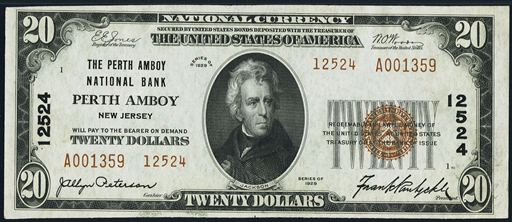The First National Bank Of Danville
The First National Bank Of Danville in Illinois printed $3,184,910 dollars worth of national currency. Over $1,000,000 face value is a lot of money. However, some types and denominations of currency from this bank could still be rare. This national bank opened in 1863 and stopped printing money in 1935, which equals a 73 year printing period. That is considering a long operation period for a national bank. During its life, The First National Bank Of Danville issued 13 different types and denominations of national currency. We have examples of the types listed below. Your bank note should look similar. Just the bank name will be different. For the record, The First National Bank Of Danville was located in Vermilion County. It was assigned charter number 113.
We buy all national currency. Please call or email us for a quote. Sales@AntiqueMoney.com
The First National Bank Of Danville in Illinois issued 5,500 sheets of $5 original series national bank notes. Just because a print range is between 5,000 and 10,000 doesn’t mean that individual notes will be easy to buy. That number isn’t really high or low. Some notes are extremely rare and some could be from a hoard. Values are determined based on condition and the number of known survivors. Each five dollar original series bank note has a spiked red seal. That is pretty much the only design difference between it and later issues. These are really beautiful notes. One neat thing about these is that the back of each note has a vignette of the corresponding state seal. Some of the state seals are very imaginative. Collecting by state seal was very popular early on in the hobby. Today most collectors are more concerned about bank of issue and condition. Serial number one bank notes are also extremely popular.
Original Series $5 National Bank Note
The First National Bank Of Danville printed 3,143 sheets of $5 series of 1875 national bank notes. Hundreds of banks had sheet outputs between 2,500 and 5,000. That is pretty typical for a medium sized national bank in the 1870s. Series of 1875 $5 bills are some of the most commonly encountered bank notes from the first charter series. Only the original series $1 bill is more available. Some banks exclusively issued five dollar bills. So if you want an example from one of those banks then you don’t have many options. These notes have a rounded red seal and red serial numbers. They also all have a red charter number.
Series of 1875 $5 National Bank Note
The First National Bank Of Danville also printed 2,317 sheets of $50 1882 brown back national bank notes. Not many banks printed $50 1882 brown backs. Sheet outputs aren’t extremely important. However, it is good factual information to know. The most common 1882 $50 brown backs are worth about $5,000. However, some can be worth more than $10,000 based on condition, serial number, and bank of issue.
Series of 1882 $50 Brown Back
The First National Bank Of Danville also printed 2,317 sheets of $100 1882 brown back national bank notes. Just because this bank printed more than 1,000 one hundred dollar brown backs does not mean that they are all common. We are very interested in purchasing $100 1882 brown back national bank notes. We have paid more than $15,000 for some examples. Send us pictures of what you have and we will respond quickly with an appraisal and offer.
Series of 1882 $100 Brown Back
The First National Bank Of Danville also printed 2,300 sheets of $50 1902 red seal national bank notes. That is also the exact number of $50 red seals printed by this bank. Each sheet contained one $50 bill and one $100 bill. They are all extremely rare. The value for a generic circulated example is usually around $4,000. Most are worth more and some can be worth considerably more. John Sherman is pictured on each note. Otherwise it has the same markings you would expect to find on any 1902 red seal.
1902 $50 Red Seal National Bank Note
The First National Bank Of Danville also printed 2,300 sheets of $100 1902 red seal national bank notes. As we said above, all high denomination 1902 red seals are extremely rare. The number of notes printed really doesn’t matter to collectors. 1902 $100 red seals are rare to the point that they are always in demand. Of course the standard valuation rules still apply. Condition and bank of issue are of paramount importance. We have paid over $12,000 for some of the rarest specimens.
1902 $100 Red Seal National Bank Note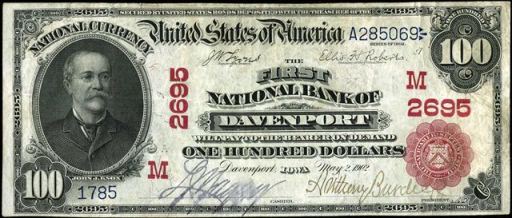
The First National Bank Of Danville also printed 5,672 sheets of $50 1902 blue seal national bank notes. There is no trick to knowing which 1902 blue seals will be common and rare. Often times the number printed won’t tell you much information. The value still comes down to condition and demand. That is a surprise to most people. In fact, most 1902 $50 bills we see are worth between $750 and $1,250. The rarer ones can be worth more than $5,000. However, there isn’t much middle ground.
1902 $50 Blue Seal National Bank Note
The First National Bank Of Danville also printed 5,672 sheets of $100 1902 blue seal national bank notes. It is no coincidence that the sheet numbers for $50 bills and $100 bills are the same. They were printed on the same sheets. Most $100 blue seals are at least scarce; others can be very rare. John J Knox is printed on the front of each bill. Most collectors like the back design a lot more though. It is really unique and different from most other national bank notes. Prices for 1902 $100 blue seals are pretty similar to $50 blue seals. They are both equally common or equally rare, depending on how you look at it.
1902 $100 Blue Seal National Bank Note
The First National Bank Of Danville also printed 1,170 sheets of Type1 1929 $50 national bank notes. That is a pretty typical sheet output for a national bank during the small size era. As is the case with all modern fifty dollar bills, Ulysses Grant is pictured on the front of 1929 $50 bills. This is a higher denomination that was only printed by 300 different national banks. Many examples are only worth around a few hundred dollars. Rarer specimens can sell for more than $1,000.
Series of 1929 Type1 $50 National Bank Note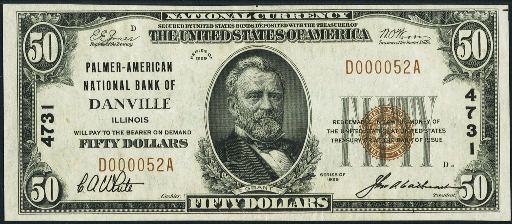
The First National Bank Of Danville also printed 372 sheets of Type1 1929 $100 national bank notes. That may sound like a very small number, and it is. However, when it comes to small size notes, that print range usually allows for a handful of survivors. Despite saying series of 1929, all type1 national bank notes were actually printed between 1929 and 1933. Exactly 289 national banks printed $100 type1 notes. Most are relatively common. However, as with anything, there are always exceptions to that rule.
Series of 1929 Type1 $100 National Bank Note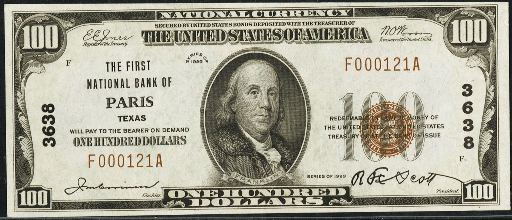
The First National Bank Of Danville also printed 2,040 individual notes from the type2 1929 $5 national bank note series. That may seem like a high number, but remember that is total notes printed for the denomination, not sheets printed. This was an easy and popular denomination for national banks. Five dollars could buy a lot of different things back in 1929 and the early 1930s. 1929 type2 five dollar bank notes are available in quantities today. However, some notes can be extremely rare. The exact value all depends on the bank of issue and condition. Contact us and we would be happy to give a free appraisal.
Series of 1929 Type2 $5 National Bank Note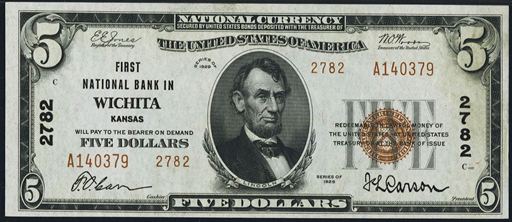
The First National Bank Of Danville also printed 900 individual notes from the type2 1929 $10 national bank note series. Type2 1929 national bank notes are already rare to begin with. A printing of less than 1,000 is especially low. The easiest way to spot the difference between type1 1929 $10 bills and 1929 type2 $10 bills is in the serial number. Type2 notes have a serial number that ends with a number. 1929 type1 notes have a serial number that ends with the letter A. Generally speaking, these $10 bills are rarer than the earlier type1 issues. However, most collectors don’t pay more for that rarity because they look basically the same.
Series of 1929 Type2 $10 National Bank Note
The First National Bank Of Danville also printed 405 individual notes from the type2 1929 $20 national bank note series. Type2 1929 national bank notes are already rare to begin with. A printing of less than 1,000 is especially low. One of the great things about 1929 type2 $20 national bank notes is that they really aren’t that old and some can be extremely rare. Until the big head $20 series started there really wasn’t much difference between something printed in 1929 and the same bill printed in 1993. We have bought some examples in the past few months that people just found in their change.
Series of 1929 Type2 $20 National Bank Note